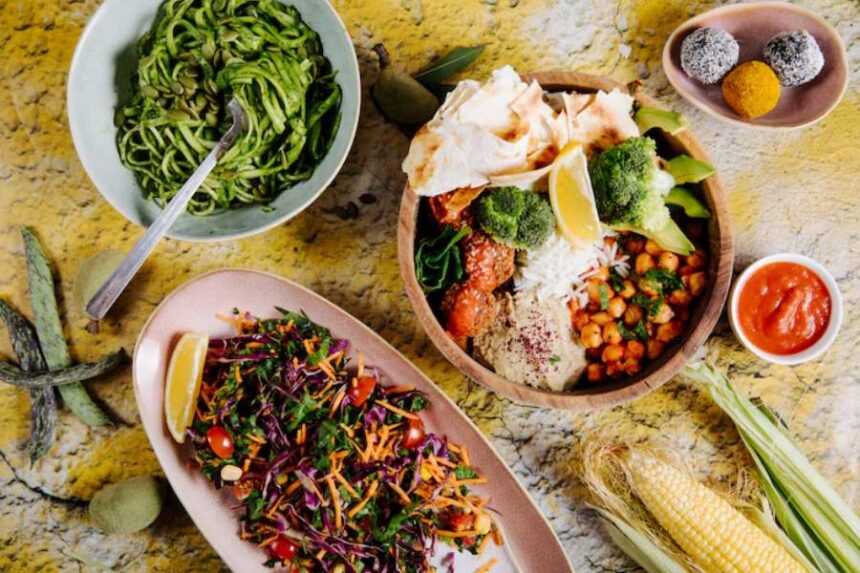Vegan food has become a cultural icon of clean eating. In marketing, media, and casual conversation, it’s often assumed to be the healthiest option by default. From wellness influencers promoting smoothie bowls to documentaries highlighting plant-based cures, veganism wears a halo.
This health halo is deeply rooted in associations. Vegan food avoids animal products, which many equate with avoiding cholesterol, saturated fat, and cruelty. That connection triggers a psychological shortcut: no meat equals healthy. Plant-based meals, by this logic, must be low in fat, low in calories, and packed with nutrients.
The reality is more nuanced. A meal free from animal products isn’t automatically low in fat or sugar. Vegan fried chicken may skip the poultry, but it still brings in the same breading, frying oils, and heavy sauces. Coconut oil, popular in vegan cooking, is high in saturated fat. Vegan desserts made with maple syrup, almond flour, or dates can still contain more calories than their dairy counterparts.
Much of the misunderstanding isn’t the restaurant’s fault. Consumers expect vegan to mean healthy, so menus adapt to the perception. Many restaurants design dishes for taste first, marketing second, and health only if it fits. It’s not a trick—it’s business. And taste sells.
This disconnect between perception and reality is further amplified by social validation. If everyone around you agrees a meal is healthy, you’re less likely to question it. The vegan movement, rooted in admirable ethical goals, has sometimes blurred the line between morality and nutritional science. Even within the community, there is confusion about what constitutes true dietary health.
Defining Healthy – It’s Not Just the Ingredients
Health isn’t a single metric. Nutritional health depends on the quality, quantity, and balance of what we eat. Marketing, however, tends to cherry-pick one attribute—no meat, organic, low-carb—and present it as a full picture. That’s misleading.
Let’s break down what healthy really means. Scientifically, a healthy meal supports bodily function, provides essential nutrients, and minimizes risks for chronic disease. That includes macronutrient balance (protein, fats, carbohydrates), vitamins and minerals, and calorie control. It also accounts for how food is prepared and served.
A raw kale salad dressed with olive oil and lemon can be nutritious. A fried jackfruit taco with processed vegan cheese and a side of chips? Less so. Both are vegan, but their health impacts differ greatly.
Processed vegan foods complicate the issue. Plant-based sausages and cheese alternatives often contain refined oils, starches, gums, and preservatives. They may lack fiber and pack as much sodium and fat as the items they replace. That doesn’t make them evil—but they aren’t nutritionally superior just for being vegan.
Another layer: individualized health needs. A dish rich in legumes may be excellent for some but problematic for others with IBS. Someone managing diabetes might struggle with high-glycemic vegan desserts. A person with iron-deficiency anemia may require careful meal planning to avoid nutritional gaps.
Health also evolves over time. A young, active person might thrive on high-carb vegan meals. An older adult with lower caloric needs or a thyroid condition might require a different approach. Understanding the dynamic nature of health is essential. A dish that supports wellness today might need to be re-evaluated tomorrow.
Behind the Scenes of the Vegan Menu
To understand what’s really happening in vegan restaurants, look beyond the buzzwords. Real menu items reveal nutritional gaps and culinary compromises. Take the common vegan burger: the patty may be made of soy or black beans, which sounds healthy. But it’s often deep-fried, topped with coconut-based mayo, and served on a white bread bun. The calorie and fat content rival fast food.
Desserts tell a similar story. Raw vegan cheesecakes made from cashews, coconut oil, and agave syrup may lack dairy and refined sugar, but they still deliver dense calories and high saturated fat. A single slice can exceed the energy of a traditional cheesecake.
Vegan pizzas are another example. A base of refined flour, a thick layer of cashew cheese, and sugary tomato sauce make for a comforting dish—not necessarily a balanced one. Add on faux meats or extra nuts, and nutritional density gives way to indulgence.
Marketing adds to the confusion. Labels like “organic,” “gluten-free,” or “cruelty-free” sound virtuous but don’t speak to nutrition. An organic, gluten-free brownie made from coconut sugar, almond meal, and vegan chocolate may still have 400+ calories per piece.
Ambiance further reinforces health perception. A space filled with reclaimed wood, a moss wall, and recycled restaurant furniture signals sustainability—but doesn’t affect what’s on the plate. Design aesthetics can suggest wellness, but they don’t dictate food quality.
Kitchen practices often lean toward flavor boosters over nutrition. Chefs may double down on oil or salt to ensure satisfaction, especially in vegan dishes that lack umami-rich animal products. Unless a restaurant deliberately minimizes additives, even “healthy” options can be nutritional traps. The mismatch between perception and plate can be startling once you analyze the actual ingredients.
Healthwashing and Menu Illusions
Many vegan restaurants participate in healthwashing—using language and visuals to make their food appear healthier than it is. Words like “clean,” “plant-based,” and “superfood” imply a health benefit that may not exist.
For instance, a menu item called “Superfood Nachos” might combine fried tortilla chips, vegan cheese, and seasoned soy crumble. Sprinkle on some chia seeds or microgreens, and it sounds clean. In reality, the dish may contain more sodium and fat than a non-vegan equivalent.
Sauces and dressings are another hidden source of calories. Cashew cream, tahini dressing, and vegan aioli sound better than ranch or mayo, but can still deliver 100–300 calories per two-tablespoon serving. Add sugars in marinades and high-sodium seasonings, and you’ve got a calorie bomb dressed in healthy-sounding language.
Color psychology and menu design play a role. Green tones, handwritten fonts, and wooden boards suggest artisanal, health-focused food. But aesthetics don’t alter ingredients. Consumers must learn to separate design from dietary value.
Further illusion comes from naming conventions. A dish labeled as a “Buddha bowl” may conjure thoughts of serenity and balance, yet its actual content could lean heavily on white rice, fried tofu, and creamy dressing. Without transparency in labeling and nutritional facts, diners are left guessing—and often misled.
When Vegan Is Healthy—And Why It Works
There are standout vegan restaurants that prioritize health. These places focus on whole foods, minimal processing, and balanced plates. They serve meals high in fiber, low in saturated fat, and rich in vitamins and minerals.
For example, a lentil and quinoa bowl with roasted vegetables and tahini-lemon dressing offers protein, complex carbs, and healthy fats. A chickpea stew with turmeric, garlic, spinach, and brown rice meets both flavor and nutrition goals.
Some restaurants even consult registered dietitians or chefs trained in nutrition. They avoid heavy oils, control portion sizes, and use seasonal produce. Instead of relying on meat substitutes, they spotlight legumes, grains, fermented foods, and cruciferous vegetables.
This kind of vegan dining promotes satiety without excess. Meals are filling due to fiber and protein, not just volume or fat. These restaurants prove it’s possible to align ethics and nutrition without sacrificing taste.
Key to their approach is plate composition. A good vegan meal includes:
- Plant protein: beans, lentils, tofu, tempeh
- Complex carbs: whole grains, starchy vegetables
- Healthy fats: nuts, seeds, avocado (in moderation)
- Non-starchy vegetables: leafy greens, crucifers, colorful produce
Restaurants that master this balance not only serve better meals—they educate through example.
These menus often reflect a farm-to-table philosophy, sourcing locally and seasonally to maximize freshness and nutrition. Presentation also plays a role: food that looks vibrant and balanced tends to reflect better nutritional value. A plate filled with a variety of textures, colors, and plant types usually signals intention, thought, and a deeper commitment to health.
How to Read Between the Lines—And the Menu
Even if a vegan restaurant doesn’t emphasize health, diners can still make smart choices. Reading a menu critically helps filter marketing from nutrition.
Start by asking a few key questions:
- What oil is used for cooking and dressing?
- Are sauces made in-house or pre-packaged?
- Are there added sugars in drinks and desserts?
Spot red flags like too many fried elements, overloaded sauces, or excessive reliance on refined carbs. A dish with three kinds of nuts, coconut oil, and no vegetables may not be as balanced as it sounds.
When ordering, consider simple swaps:
- Baked tofu over fried tempeh
- Vinaigrette over cream-based dressing
- Water, tea, or black coffee instead of sweetened lattes
Sharing large portions or boxing half to go helps manage calorie intake without sacrificing enjoyment. Portion control isn’t about restriction—it’s a practical tool.
Menus may not list everything, so don’t hesitate to ask. Questions show that customers care, and restaurants may adapt when demand for healthier options grows. Empower yourself with knowledge, and use each dining opportunity as a chance to eat well while supporting vegan values.
Closing the Gap Between Ethics and Health
Ethical veganism centers on reducing animal harm, while nutritional health focuses on supporting the human body. These aims don’t always align, but they don’t have to conflict.
Diners can push restaurants toward healthier offerings by asking for more whole foods and fewer ultra-processed items. When customers choose fiber-rich, minimally processed meals, demand shapes supply.
Fortunately, a new generation of vegan chefs is bridging this gap. They’re building menus around nutritional diversity and environmental sustainability. The nutrient-dense vegan restaurant is no longer a fringe idea—it’s gaining momentum.
The goal isn’t to give up vegan restaurants but to support those offering food that nourishes body and values alike. Next time you order a quinoa salad or jackfruit wrap, don’t be swayed by buzzwords or reclaimed wood. Ask what’s in it, and let that answer guide your plate.
Because eating vegan can be a powerful choice—when it’s a smart one, too. Nutrition and ethics aren’t opposing forces. They’re partners in building a better way to eat, live, and think about food.




